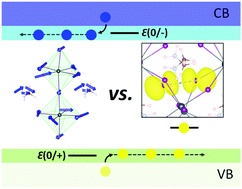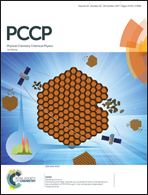Shallow trapping vs. deep polarons in a hybrid lead halide perovskite, CH3NH3PbI3†
Abstract
There has been considerable speculation over the nature of charge carriers in organic–inorganic hybrid perovskites, i.e., whether they are free and band-like, or they are prone to self-trapping via short range deformation potentials. Unusually long minority-carrier diffusion lengths and moderate-to-low mobilities, together with relatively few deep defects add to their intrigue. Here we implement density functional methods to investigate the room-temperature, tetragonal phase of CH3NH3PbI3. We compare charge localization behavior at shallow levels and associated lattice relaxation versus those at deep polaronic states. The shallow level originates from screened Coulomb interaction between the perturbed host and an excited electron or hole. The host lattice has a tendency towards forming these shallow traps where the electron or hole is localized not too far from the band edge. In contrast, there is a considerable potential barrier that must be overcome in order to initiate polaronic hole trapping. The formation of a hole polaron (I2− center) involves strong lattice relaxation, including large off-center displacement of the organic cation, CH3NH3+. This type of deep polaron is energetically unfavorable, and active shallow traps are expected to shape the carrier dynamics in this material.



 Please wait while we load your content...
Please wait while we load your content...